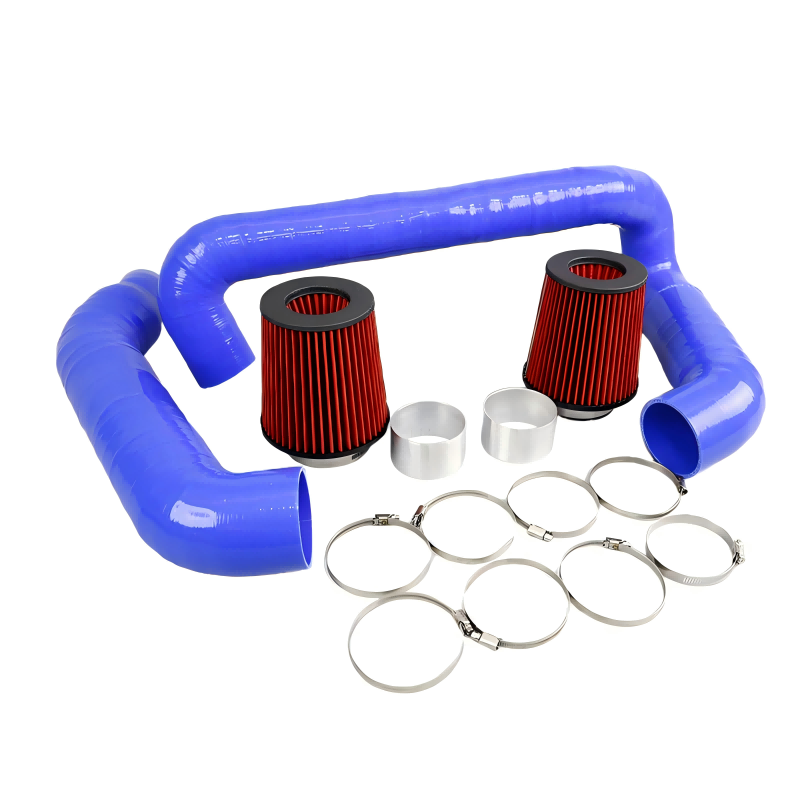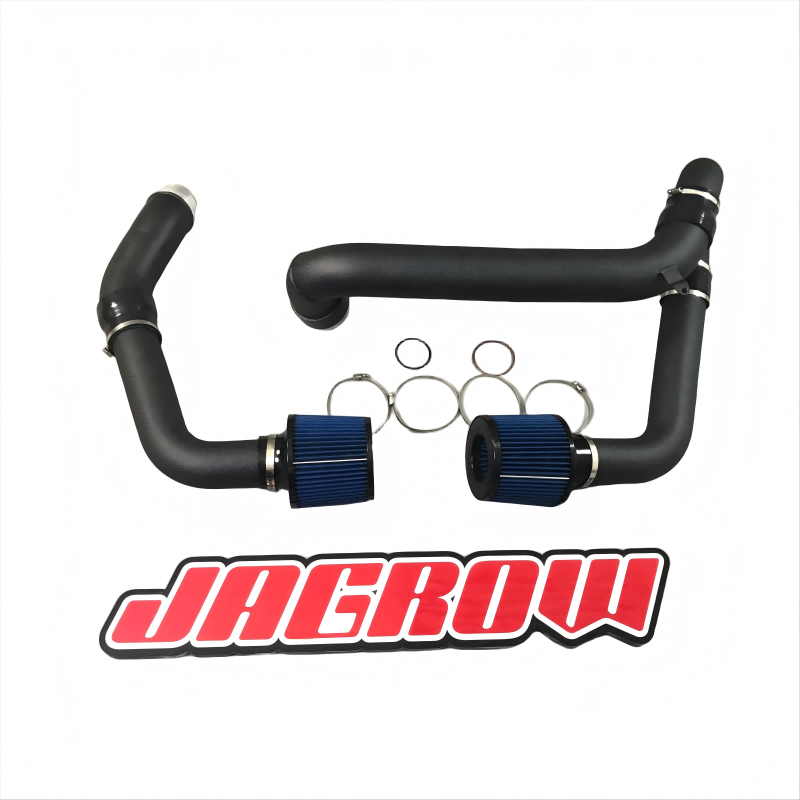Ventajas y desventajas de los sistemas de admisión de silicona frente a los de aluminio en la industria del tuning automotriz
Cuando se trata de tuning y mejoras de rendimiento automotriz, uno de los componentes clave que se suele mencionar es el sistema de admisión. Este sistema desempeña un papel fundamental en la eficiencia y el rendimiento general del motor, ya que es responsable de dirigir el aire hacia el motor. Para los entusiastas que buscan mejorar los sistemas de admisión de sus autos, dos materiales populares para los tubos de admisión son la silicona y el aluminio. Ambos materiales tienen sus ventajas y desventajas, que pueden influir en la decisión según las necesidades, el propósito y el presupuesto del vehículo.
En este blog, exploraremos los pros y los contras de los sistemas de admisión de silicona y de los sistemas de admisión de aluminio para ayudarlo a tomar una decisión informada para su proyecto de modificación de automóvil.
Ventajas:
1. Flexibilidad y personalización: Las mangueras de silicona son muy flexibles, lo que las hace ideales para diseños de admisión personalizados. Se doblan fácilmente sin enroscarse, lo que permite mayor libertad en el tendido del sistema de admisión. Esto es especialmente útil para espacios reducidos o construcciones personalizadas donde la precisión es clave.
2. Durabilidad a altas temperaturas: La silicona soporta altas temperaturas sin degradarse, lo que la convierte en una opción ideal para vehículos de alto rendimiento, especialmente aquellos sometidos a un uso intensivo, como los de carreras. Son resistentes a los altos niveles de calor del motor y el escape, lo que garantiza un rendimiento duradero.
3. Ligereza: En comparación con los tubos metálicos, las mangueras de silicona son increíblemente ligeras. Esto ayuda a reducir el peso total del vehículo, lo cual es crucial para construcciones orientadas al rendimiento, donde cada gramo cuenta.
4. Resistencia a la corrosión: La silicona es altamente resistente a la corrosión y la oxidación. Esto significa que, incluso en ambientes húmedos o salinos, las mangueras de silicona no se oxidan ni se degradan, lo cual puede ser un problema con los sistemas de admisión metálicos.
5. Reducción de ruido: La silicona tiene propiedades naturales de amortiguación de vibraciones. Esto produce un sonido de admisión más silencioso y refinado en comparación con el ruido metálico más áspero generado por los tubos de aluminio.

Contras:
1. Menos atractivo estético: Si bien las mangueras de silicona vienen en varios colores, podrían no satisfacer la estética de algunos entusiastas que prefieren un aspecto más refinado y sofisticado. Los sistemas de aluminio suelen ofrecer un acabado más elegante y profesional.
2. Resistencia limitada al aceite y al combustible: La silicona puede degradarse al exponerse a ciertos aceites, combustibles o aditivos químicos, especialmente en motores de alto rendimiento donde estas sustancias pueden estar presentes. En algunos casos, la exposición prolongada a estos elementos podría provocar grietas o averías.
3. Propensión a la expansión térmica: Aunque la silicona puede soportar altas temperaturas, sigue siendo susceptible a la expansión térmica. Esto podría provocar que la manguera se expanda ligeramente en condiciones extremas, lo que podría afectar el rendimiento o causar un sellado deficiente si no se instala correctamente.
1. Ventajas: Estética: Los tubos de admisión de aluminio ofrecen un acabado elegante y brillante, apreciado por su aspecto limpio y pulido. Para muchos entusiastas de los autos, este aspecto pulido realza el atractivo general bajo el capó.
2. Resistencia y durabilidad: El aluminio es un material robusto y altamente resistente a daños físicos. No se agrieta ni se rompe tan fácilmente como la silicona, lo que lo convierte en una opción robusta para aplicaciones de alto rendimiento sometidas a mucha tensión o condiciones de conducción extremas.
3. Control de temperatura: El aluminio posee una excelente conductividad térmica, lo que significa que puede disipar el calor con mayor eficacia que el silicona. Esto puede resultar en temperaturas de admisión más bajas, lo que podría mejorar el rendimiento del motor, especialmente en configuraciones de inducción forzada, como vehículos turboalimentados o sobrealimentados.
4. Bajo mantenimiento: El aluminio no se desgasta tanto como la silicona. Es resistente a numerosos productos químicos, como aceites y combustibles, lo que lo convierte en una opción más duradera en entornos con presencia de estos fluidos.
5. Ajuste preciso: Dado que los tubos de admisión de aluminio suelen fabricarse con metal, se pueden fabricar con precisión para un ajuste perfecto. Esta precisión suele resultar en un sistema de admisión más rígido y estable que conserva su forma con el tiempo.

Contras:
1. Más pesado que la silicona: El aluminio es significativamente más pesado que la silicona, lo que puede ser un problema para quienes buscan reducir el peso total de su vehículo. Si bien la diferencia puede no ser considerable, podría ser significativa para autos de pista o de carreras, donde cada peso cuenta.
2. Más caro: Los sistemas de admisión de aluminio suelen ser más caros que las alternativas de silicona. El coste se atribuye al proceso de fabricación y a los propios materiales. Para los entusiastas con presupuesto ajustado, esto puede ser un factor disuasorio.
3. Riesgo de agrietamiento o abolladuras: Si bien el aluminio es duradero, también es propenso a abollarse y agrietarse bajo una fuerza o impacto extremos. Esto podría ser un problema para vehículos expuestos regularmente a entornos hostiles o condiciones todoterreno.
4. Flexibilidad limitada: A diferencia de la silicona, los tubos de admisión de aluminio son rígidos y no se doblan fácilmente. Esto significa que la personalización del recorrido de admisión puede ser limitada, especialmente en espacios reducidos. Además, un ajuste inadecuado podría provocar fugas o un flujo de aire deficiente.
1.
Tanto los sistemas de admisión de silicona como los de aluminio tienen sus ventajas, y la mejor opción dependerá de las necesidades de su automóvil, su presupuesto y los objetivos específicos de su mejora de rendimiento.
l Elija silicona si:
1. Necesita una solución flexible, ligera y rentable.
2. Estás trabajando en una construcción personalizada donde el enrutamiento y el ajuste son cruciales.
3. Prioriza la facilidad de instalación y la reducción de ruido.
4. Su automóvil funciona en un entorno relativamente limpio (no expuesto a demasiados aceites o productos químicos).
l Elija aluminio si:
1. Buscas una apariencia más pulida y profesional.
2. Su enfoque está en la durabilidad, la fuerza y la resistencia al impacto.
3. Desea una disipación de calor superior y un control de temperatura para aplicaciones de alto rendimiento.
4. Su automóvil está expuesto a duras condiciones y necesita una admisión que requiera poco mantenimiento y sea resistente a los daños.
o
Al final, ambos materiales pueden mejorar el rendimiento y la estética de su sistema de admisión, pero comprender sus propiedades únicas le garantizará que tome la mejor decisión para su vehículo.
¿Ya actualizaste tu sistema de admisión? ¿Qué material elegiste y por qué? ¡Cuéntanos qué te pareció en los comentarios!